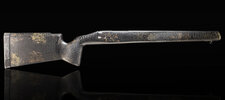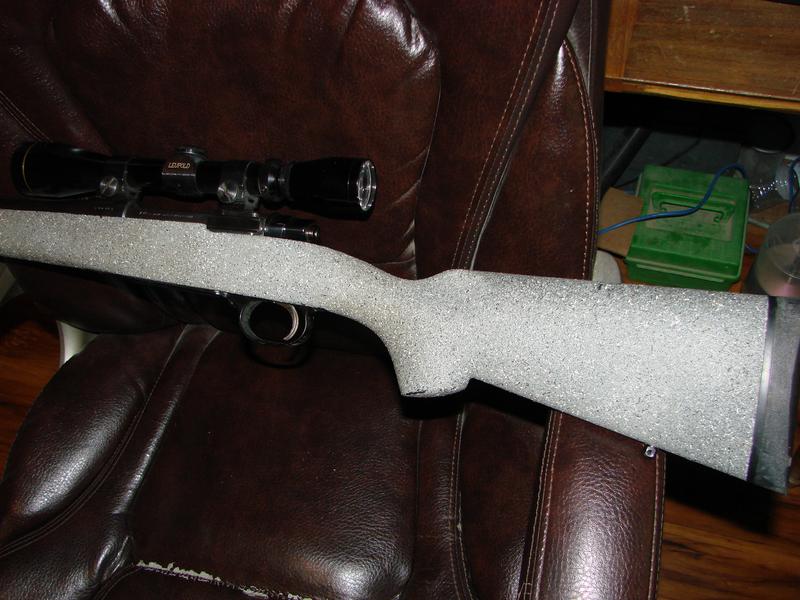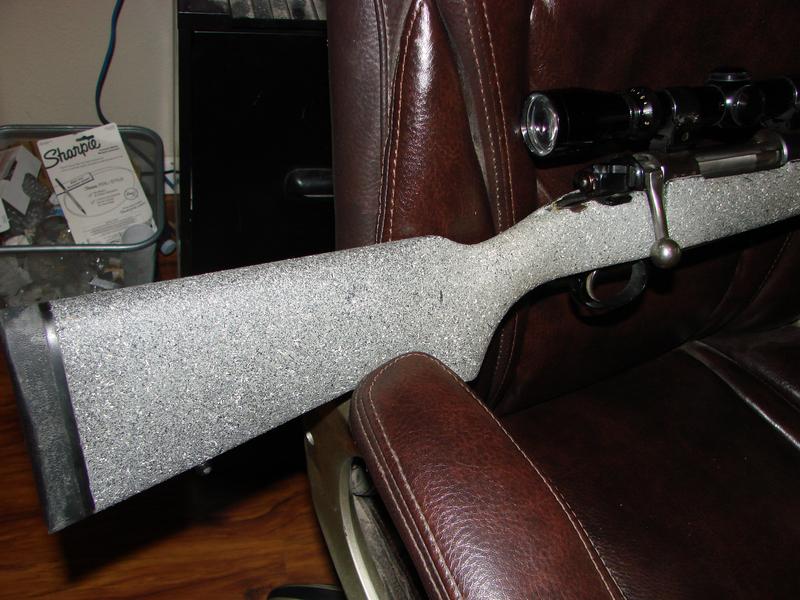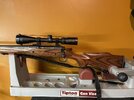This is related to my ongoing 35 Whelen project that I've been discussing in another post, but I thought this merited it's own thread. For those not following along over there, I'm converting an old Remington 700 ADL (blind magazine) into a 35 Whelen using a prefit barrel and Rem/Age style barrel nut. The barrel will be a relativley standard sporter of some flavor. The rifle used to wear a Boyd's lightweight thumbhole stock. Ultimately, the new version will get a new stock and be converted to a BDL (hinged floor plate). What stock to get is what I'm thinking on at the moment.
Ultimately, this is probably going to come down to how much I want to spend and how much weight I want to try to save in the stock. I get that, but I would like some feedback on the stocks I'm considering from the vast experience here. I'm not married to any of these, so if you have other suggestions I'm all ears. As you may tell from my options below, I'm generally trying to stay under the price range of the McMillans and Manners. I'm sure they are great, but that's just an awful lot of money for a stock. I'm also not going superlite with this build, though weight is a consideration.
A couple of additional consdierations: (1) The Rem/Age barrel nut. I'm generally assuming most of these will require some minor fitting to free-float the barrel nut, but if you have any specific experience with that on these or other stocks I'm all ears. (2) Stock shape. The Whelen isn't an elephant gun or anything, but it's going to kick about like a 300 win mag. I've heard of some stock designs being better for heavy recoil than others, but frankly the information on the internet seems contradictory on this point. If you have experience with any particular stock type or stock shape being better or worse for stiff recoil, I'm interested in that too.
My initial thought for this rifle was a Boyd's Heritage stock using plain walnut wood and adding fleur de'lis checkering. Price from Boyd's for it setup the way I'm thinking is $381, and I expect it to weigh 2.5 - 2.8 pounds based on Boyd's website. I would pillar and glass bed it myself (something I've done before). The stock would look something like this:
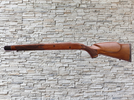
Traditional and pretty, though not extravagant. Two main potential drawbacks: weather and weight. This rifle is not a need by any means. It's a build just because I want to. I have more practical rifles. But . . . should I get the chance to chase wapiti in grizzly country (which I may in the next 5 years), I think I would take this rifle along. And as some other folks gently reminded me in my other thread, when chasing elk function matters more than form. I've been going back and forth about wood vs. synthetic for a while, and I'm still teetering and considering options. Here are some of the other stocks I'm considering.
First up, and least expensive, is a Stocky's composite. Pros: appears to be a solid fiberglass composite stock with an aluminum bedding block for about $220. Cons: Not saving any weight since it's listed at 2.85 pounds. So, I might actually be gaining weight going this direction. And like basically all composite stocks, it's less pretty than the walnut. I have no experience with this stock, so if you do (good or bad) I'd like to hear about it.
Next in order of cost is Grayboe's Outlander stock. Redhawk lists it for under $320, and it's supposed to weigh just under 2 pounds (30 ounces). It's a very plain stock, but I'm frankly intrigued by it. In addition to the stock itself, Redhawk lists a package with their BDL bottom metal for under $500, and I'm going to need bottom metal too. If you have any experience with this stock or other Grayboe stocks (or even Redhawk's bottom metal) I'd be interested in your experience.
Two more options are Bell and Carlson's BDL Light Hunter and regular BDL sporter. Both list at $340, though I've seen them cheaper before. The light hunter is supposed to weigh 2.1 pounds and the sporter is supposed to weigh 2.25 pounds. Both have aluminum bedding blocks. As far as I can tell, B&C saved weight on the light hunter by slimming down the forend.
A final option is an H-S Precision sporter. Stocky's lists it for $424. It's supposed to weigh 2.5 pounds. I hear good things about H-S Precision stocks, but they are on the expensive end of what I'm considering at the moment and I don't save much weight over wood. Still, I don't want to cheap out too much on this build either. If they are the best option and worth it, I'll spend the money.
Ultimately, this is probably going to come down to how much I want to spend and how much weight I want to try to save in the stock. I get that, but I would like some feedback on the stocks I'm considering from the vast experience here. I'm not married to any of these, so if you have other suggestions I'm all ears. As you may tell from my options below, I'm generally trying to stay under the price range of the McMillans and Manners. I'm sure they are great, but that's just an awful lot of money for a stock. I'm also not going superlite with this build, though weight is a consideration.
A couple of additional consdierations: (1) The Rem/Age barrel nut. I'm generally assuming most of these will require some minor fitting to free-float the barrel nut, but if you have any specific experience with that on these or other stocks I'm all ears. (2) Stock shape. The Whelen isn't an elephant gun or anything, but it's going to kick about like a 300 win mag. I've heard of some stock designs being better for heavy recoil than others, but frankly the information on the internet seems contradictory on this point. If you have experience with any particular stock type or stock shape being better or worse for stiff recoil, I'm interested in that too.
My initial thought for this rifle was a Boyd's Heritage stock using plain walnut wood and adding fleur de'lis checkering. Price from Boyd's for it setup the way I'm thinking is $381, and I expect it to weigh 2.5 - 2.8 pounds based on Boyd's website. I would pillar and glass bed it myself (something I've done before). The stock would look something like this:

Traditional and pretty, though not extravagant. Two main potential drawbacks: weather and weight. This rifle is not a need by any means. It's a build just because I want to. I have more practical rifles. But . . . should I get the chance to chase wapiti in grizzly country (which I may in the next 5 years), I think I would take this rifle along. And as some other folks gently reminded me in my other thread, when chasing elk function matters more than form. I've been going back and forth about wood vs. synthetic for a while, and I'm still teetering and considering options. Here are some of the other stocks I'm considering.
First up, and least expensive, is a Stocky's composite. Pros: appears to be a solid fiberglass composite stock with an aluminum bedding block for about $220. Cons: Not saving any weight since it's listed at 2.85 pounds. So, I might actually be gaining weight going this direction. And like basically all composite stocks, it's less pretty than the walnut. I have no experience with this stock, so if you do (good or bad) I'd like to hear about it.
Next in order of cost is Grayboe's Outlander stock. Redhawk lists it for under $320, and it's supposed to weigh just under 2 pounds (30 ounces). It's a very plain stock, but I'm frankly intrigued by it. In addition to the stock itself, Redhawk lists a package with their BDL bottom metal for under $500, and I'm going to need bottom metal too. If you have any experience with this stock or other Grayboe stocks (or even Redhawk's bottom metal) I'd be interested in your experience.
Two more options are Bell and Carlson's BDL Light Hunter and regular BDL sporter. Both list at $340, though I've seen them cheaper before. The light hunter is supposed to weigh 2.1 pounds and the sporter is supposed to weigh 2.25 pounds. Both have aluminum bedding blocks. As far as I can tell, B&C saved weight on the light hunter by slimming down the forend.
A final option is an H-S Precision sporter. Stocky's lists it for $424. It's supposed to weigh 2.5 pounds. I hear good things about H-S Precision stocks, but they are on the expensive end of what I'm considering at the moment and I don't save much weight over wood. Still, I don't want to cheap out too much on this build either. If they are the best option and worth it, I'll spend the money.
Last edited:



